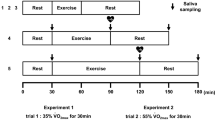Summary
The influence of naloxone on the peristaltic reflex of isolated segments of various parts of the guinea pig small intestine was examined. The narcotic antagonist (−)naloxone (2×10−7M), but not its stereoisomer (+)naloxone, increased the frequency of peristaltic waves in ileal segments by an average of 12%. In addition, it decreased the length and number of peristalsis-free intervals during periods of elevated intraluminal pressure. Thus, it increased over-all-peristaltic-activity by 25–60%, dependent upon intraluminal pressure.
Segments from the duodenum and the proximal or distal jejunum displayed no statistically significant increase of peristalsis after naloxone application.
Despite differences in over-all-peristaltic-activity, opiate receptor blockade by naloxone induced changes of a comparable magnitude in preparations from both fetal and adult animals. Neither pregnancy nor enforced prolonged work of the isolated segments enhanced the influence of naloxone relative to normal adult animal preparations.
It is concluded that intestinal opioids participate in the control of peristalsis in preparations taken from normal animals rather than being activated only in special in vivo or in vitro circumstances such as pregnancy or fatigue, or at a particular phase of life, for example, during fetal stages.
Similar content being viewed by others
References
Gustafsson, L., Hedqvist, P., Fredholm, B. B., Lundgren, G.: Inhibition of acetylcholine release in guinea pig ileum by adenosine. Acta Physiol. Scand. 104, 469–478 (1978)
Gyang, E. A., Kosterlitz, H. W., Lees, G. M.: The inhibition of autonomic neuro-effector transmission by morphine-like drugs and its use as a screening test for narcotic analgesic drugs. Naunyn-Schmiedebergs Arch. Exp. Pathol. Pharmakol. 248, 231–246 (1964)
Jijima, I., Minamikawa, J.-J., Jacobson, A. E., Brossi, A., Rice, K. C., Klee, W. A.: Studies in the (+)-morphinan series. 5. Synthesis and biological properties of (+)-naloxone. J. Med. Chem. 21, 398–400 (1978)
Kosterlitz, H. W., Watt, A. J.: Kinetic parameters of narcotic agonists and antagonists, with particular reference to N-allylnoroxymorphone (naloxone). Br. J. Pharmacol. Chemother. 33, 266–276 (1968)
McKnight, A. T., Sosa, R. P., Hughes, J., Kosterlitz, H. W.: Biosynthesis and release of enkephalins. In: Characteristics and function of opioids (J. M. van Ree, L. Terenius, eds.). Proc. Int. Narc. Res. Confer., Noordwijkerhout, Netherlands, July 1978; Developments in neuroscience, Vol. 4, pp. 259–269. Amsterdam: Elsevier/North-Holland Biomedical Press 1978
Pert, C. B., Snyder, S. H.: Opiate receptor: Demonstration in nervous tissue. Science 179, 1011–1014 (1973)
Puig, M. M., Gascón, P., Musacchio, J. M.: Electrically induced opiate-like inhibition of the guinea-pig ileum: Cross-tolerance to morphine. J. Pharmacol. Exp. Ther. 206, 289–302 (1978)
Schaumann, O., Giovannini, M., Jochum, K.: Morphinähnlich wirkende Analgetika und Darmmotorik. I. Spasmolyse und Peristaltik. Naunyn-Schmiedebergs Arch. Exp. Pathol. Pharmakol. 215, 460–468 (1952)
Schulz, R., Wüster, M., Simantov, R., Snyder, S., Herz, A.: Electrically stimulated release of opiate-like material from the myenteric plexus of the guinea pig ileum. Eur. J. Pharmacol. 41, 347–348 (1977)
Smith, T. W., Hughes, J., Kosterlitz, H. W., Sosa, R. P.: Enkephalins: Isolation, distribution and function. In: Opiates and endogenous opioid peptides (H. W. Kosterlitz, ed.). Proc. Int. Narc. Res. Club Meeting, Aberdeen, 1976, 57–62. Amsterdam: Elsevier/North-Holland Biomedical Press 1976
Stewart, J. J., Weisbrodt, N. W., Burks, Th. F.: Central and peripheral actions of morphine on intestinal transit. J. Pharmacol. Exp. Ther. 205, 547–555 (1978)
Trendelenburg, P.: Physiologische und pharmakologische Versuche über die Dünndarmperistaltik. Naunyn-Schmiedebergs Arch. Exp. Pathol. Pharmakol. 81, 55–129 (1917)
Van Nueten, J. M., Janssen, P. A. J., Fontaine, J.: Unexpected reversal effects of naloxone on the guinea pig ileum. Life Sci. 18, 803–810 (1976)
Waterfield, A. A., Kosterlitz, H. W.: Stereospecific increase by narcotic antagonists of evoked acetylcholine output in guineapig ileum. Life Sci. 16, 1787–1792 (1975)
Author information
Authors and Affiliations
Rights and permissions
About this article
Cite this article
Kromer, W., Pretzlaff, W. In vitro evidence for the participation of intestinal opioids in the control of peristalsis in the guinea pig small intestine. Naunyn-Schmiedeberg's Arch. Pharmacol. 309, 153–157 (1979). https://doi.org/10.1007/BF00501223
Received:
Accepted:
Issue Date:
DOI: https://doi.org/10.1007/BF00501223




